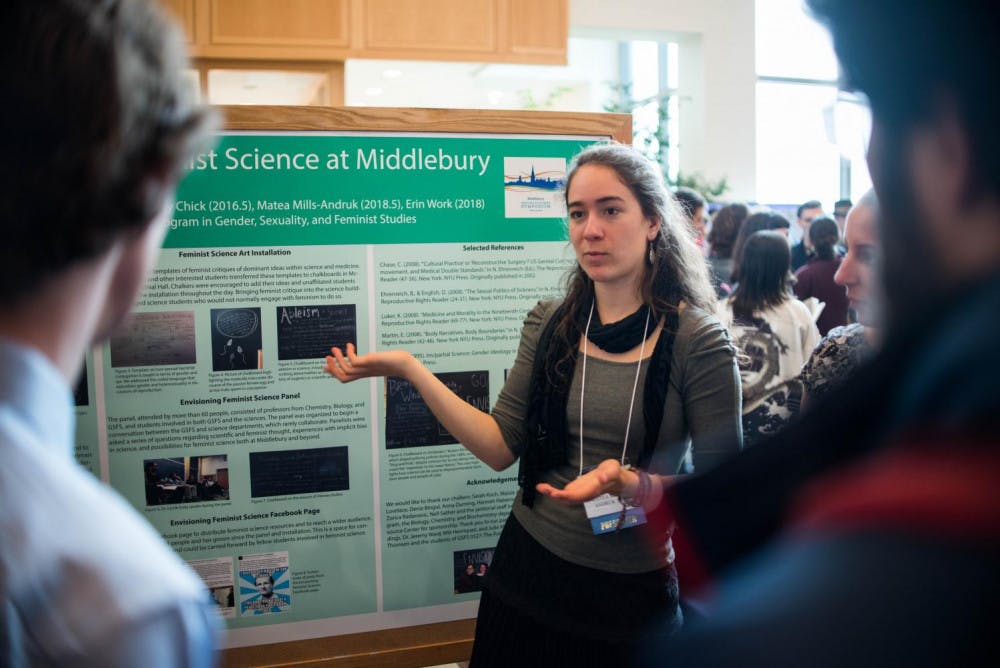A friend of mine told me in confidence on Friday, “I’ve never seen so many people in McCardell Bicentennial Hall. It’s weird, seeing so many random people here.”
Indeed, a larger than usual fraction of the Middlebury community was found inside the colossal slate building on Friday, April 21, munching on croissants and cookies and rushing between the third and fourth floors in fifteen-minute increments to attend their friends’ presentations. At the College’s 11th annual 2017 Spring Student Symposium, 286 students across many disciplines shared their academic and creative works in oral and poster presentations, both at the College and off campus. Many of the projects came from students pursuing a diverse array of STEM-related fields, from the genetic effects of caffeine consumption to the quantum hall effect.
At the first poster session, a particularly memorable project was that of Elizabeth Green ’17, who worked with Professor of Environmental and Biosphere Studies Stephen Trombulak on “Intraspecific variation in morphology of larval amphibians and the influence of morphology on predator-prey interactions.” Green’s station was difficult to reach due to the constant crowd of people surrounding her and her poster, but eventually I managed to listen to her spiel.
Basing her research on the observation that morphology impacts how individuals behave in ecological communities, Green focused on larval amphibian morphology and how it impacts the predator-prey relationship between the spotted salamander and gray tree frogs. Collecting samples from various ponds in Missouri, Green performed linear and geometric morphology analysis by carefully detailing the changes she observed in the morphology of her specimens. Following statistical analysis and plotting her geometric and linear data, she concluded that although neither linear nor geometric, shape followed a constant trend of variation between specimens of different ponds. However, the best indication of predator-prey outcome turned out to be the mean pond and larval density, or how densely populated a particular pond sample was. A compelling conclusion to round off a compelling presentation, Green’s hard work came through in the skillful way she fielded questions from her devoted listeners.
Appealing to another area of scientific interest, Felix Wang ’16.5 presented on his thesis research for the Physics Department, “On the Efficiency of Bio-inspired Dual-wing Generator.” In his project, Wang explains how scientists and engineers have used models of the mechanics of bird flight to extract energy out of the flow of a bird’s wing and convert it into electricity. In doing so, a German Robotics company created the dual-wing generator in 2014, which mimics the bird’s wing movement for electricity production and wind energy extraction.
In his thesis, Wang sought to elucidate if the dual wing generator prototype was able to surpass the efficiency of current wind turbines at low wind speeds. Using a fluid dynamics software package, Wang developed a module that made refinements using a finite element method, where he simulated the dual wing generator’s performance under various conditions. He found that the dual-wing generator utilized the suction effect to achieve a higher aerodynamic efficiency in certain situations and discussed other interesting observations while showing a colorful computational simulation during his presentation.
The Symposium also highlighted several projects that investigated science from a social lens. Brooke Angell ’18 presented on independent work she performed in Chile last semester, in which she asked elementary schoolchildren to draw a scientist and observed the emergence of existing stereotypes in their products. Converging on a topic of some political controversy, Ariana Mills ’17 and Katie O’Neill ’17.5 applied a comprehensive scientific understanding to the notion of empathy and justifying myriad reactions to sexual trauma.




